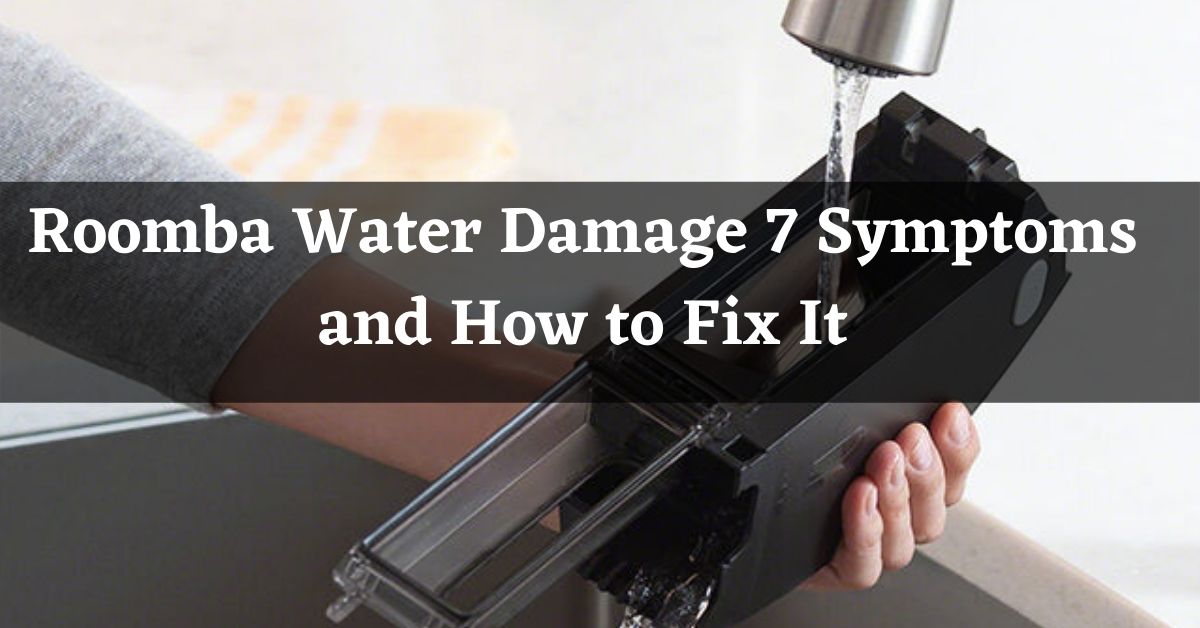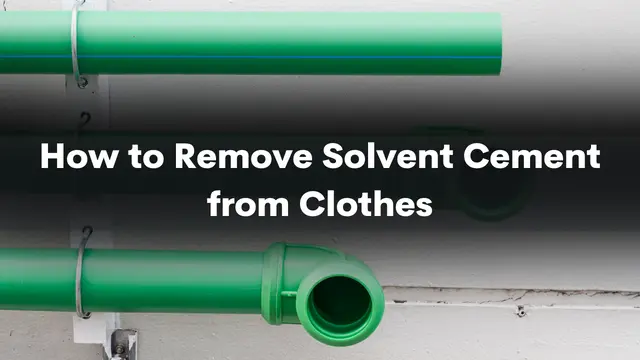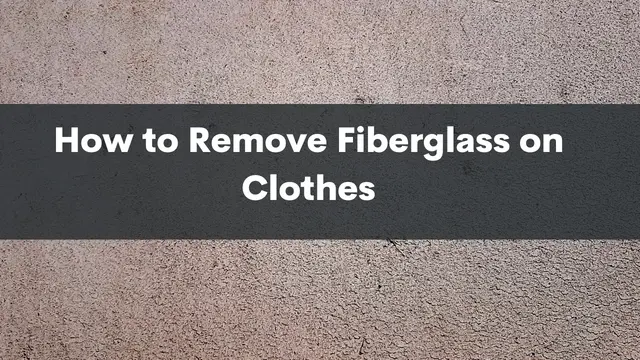Everyone knows their Roomba shouldn’t get into contact with any liquid. It’s even in the manual to ensure you keep water as far away as possible from the Roomba’s path. But accidents happen.
No one plans it, but the Roomba might accidentally run over water. That will lead to what we call Roomba water damage? But then it’s not always you’ll know your Roomba got into water?
So, what are the symptoms?
Contents
Symptoms of Roomba Getting into Water
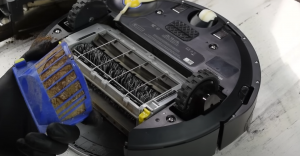
When your Roomba accidentally runs over water on the floor, here is how you will know:
1. The Roomba Can’t Charge/ Function
The damage can be severe or mild when the Roomba runs over water. Most electronics don’t have an affinity for water, and the Roomba is no different. Therefore, you notice the Roomba can’t charge or do everyday functions.
While that might be because of other issues, it could also be due to water exposure. Water contact is detrimental to the Roomba. If its base gets wet, the Roomba will cease to charge. That’s if it resumes work at all.
Sometimes you might notice the battery charging, but it doesn’t keep the charge. You charge for hours on end and still see the battery is empty. That points to water damage.
2. The Roomba Doesn’t Detect Obstacles
The idea behind the movement of the Roomba is simple. Barriers help it detect the zone in which it needs to clean. Water can damage the Roomba’s sensors and cause them not to restrict themselves within the virtual barriers.
You will thus see disjointed movement from the Roomba. It will struggle to do essential things and often go around in circles. That won’t enable it to do any cleaning.
3. Burning Smell When Roomba is Operating
The water inside the Roomba machine can have catastrophic consequences. When you turn it on, you might notice the Roomba produces smoke and a burning smell. That could point to severe water damage in the robot.
4. Roomba Can’t Turn On
Water damage will cause a Roomba cleaning robot not to turn on. There might be the usual lights that show it is okay. But then it doesn’t respond to any of the buttons you press, including on the switch.
That can only mean one thing: water has entered the robot and destroyed it.
5. Difficulty Docking
For minor exposure to water, you’ll notice the Roomba finding it difficult to dock. A normal Roomba should be able to find its way to its station. A water-compromised Roomba will struggle with this most basic of things.
When you see that, the culprit is most probably water.
6. Defective Filter
The filter will struggle to do its job if any water touches it. That makes the Roomba both inefficient and quite a bore. If you see that, then suspect water damage.
7. Loss of Suction
If your Roomba vacuum is relatively new, there is no reason for it to lose suction suddenly. Sometimes this might be as insufficient suction. You will start noticing that the vacuum is not picking up all the dirt it used to pick up before.
Water is usually the most likely culprit, although other things can make a reasonably new Roomba lose suction.
There is a risk of water damage if the Roomba comes into contact with water. If the device falls into a pool or puddle, for example, the electronic components inside may short-circuit and be damaged.
What Happens When the Roomba Runs Over Water?
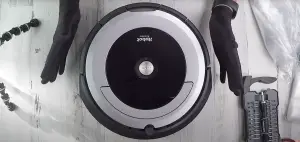
1. Damage to the Motherboard
The Roomba isn’t waterproof, and thus exposure to water is likely fatal to the motherboard. A dead motherboard is synonymous with a dead Roomba. But how do you know if the motherboard is dead? Simple.
Get a screwdriver and open up the Roomba. That is pretty straightforward. Check for either burn or rust signs on the motherboard. If you see any and have noticed the symptoms mentioned above, it is time to change the motherboard.
A replacement motherboard will get the vacuum working well again. That’s if the water didn’t damage any other parts, such as the sensors and the motor. However, the motherboard is the footstone of all the other parts.
That means fixing it will most likely solve your Roomba problems. You won’t like to hear that fixing a dead motherboard is easier said. The best option is to get a new Roomba.
You might even find that the cost of replacing the motherboard might be close to the price of a new robot vacuum.
2. Damage To the Battery and Filter
Nearly all the time a Roomba runs over water, the filter and battery will sustain damage in some form. The filters work to collect the fine dust particles as the Roomba cleans.
If the Roomba runs over water, the water goes to the filter and makes this dust muddy. With that, there is no going back to normal for the filter. The filter won’t be able to do its routine work.
3. A Dead Motor and Defective Wheels
When your Roomba contact with water, the wheels might start acting up. You might see the Roomba going around in circles instead of moving in the right direction. That will also point to a dead motor.
A dead motor is often likely the result of too much exposure to water.
4. Defective Sensors
A Roomba’s sensors enable it to navigate the home and avoid obstacles. So, if water gets to the sensor, it malfunctions. You will start seeing the sensors banging into obstacles it easily avoided when still okay.
What Can I do When Roomba Touches Water?
You can’t always avoid a Roomba getting into liquids on the floor. In case that happens, here are the actions you should take:
- Remove the battery and dismantle the Roomba
- Use a hairdryer to dry the Roomba. Alternatively, you can also place it in the sun
- Remove the vacuum’s filter and replace it as soon as possible
- Cleaning the inside parts of the Roomba with isopropyl alcohol can also help dry them
- Get a new battery if the current one isn’t working
- Test to see if the Roomba is working
- If it isn’t, check for issues with the motherboard
Why Can’t a Roomba Avoid Water?
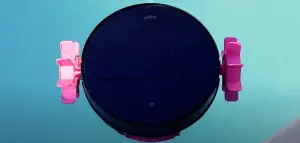
The Roomba, although an intelligent robot, can’t distinguish between liquids on the floor and dirt. It will run over anything in its path, provided the obstacle isn’t large enough.
That’s why you should never have the Roomba clean an area with water or any other liquid on the floor.
If you notice any liquid on the floor and want to deploy your Roomba, clean the area first.
Can You Rinse a Roomba?
You can’t rinse a Roomba. What you can do is wipe off the dirt with a damp cloth. But never attempt to rinse the Roomba in water. Roombas aren’t waterproof, and neither are they water-resistant.
Sometimes, Yes, you can rinse a Roomba. It is important to keep the brushes and other parts clean so that it can continue to pick up dirt and debris.
- To rinse the Roomba, first, remove the dustbin and filters.
- Next, fill a sink or bucket with warm water and add a small amount of dish soap. Submerge the brushes and other parts in the water and let them soak for a few minutes.
- Then use a brush or your hands to scrub off any built-up dirt or debris. Rinse everything off with warm water and allow it to air dry before putting it back together.
Can Water Void Roomba Warranty?
Yes. Letting the Roomba get into contact with water will make you lose the warranty. Warranties often cover Roomba issues that happen through no fault of your own. Letting the Roomba touch water isn’t one of them.
Therefore, you won’t get to use the warranty to fix Roomba water damage. The best thing you can do is ensure all liquids are off the floor when you unleash the Roomba on it.
It is best on dry floors, after all.
What Are Some Tips for Preventing Roomba Water Damage?
There are a few things you can do to help prevent Roomba water damage. First, always make sure that the robot is in its docking station when not in use. This will help to keep it from accidentally falling into the water. If your robot does happen to fall into the water, be sure to unplug it and remove the battery immediately. Do not try to turn it on again; this could cause further damage.
- One way is to make sure that the water reservoir is always full.
- Another way is to make sure that the Roomba does not come into contact with any water sources.
- Finally, it is important to clean the Roomba regularly to remove any dirt or debris that could potentially cause water damage.
FAQ About Roomba Water Damage
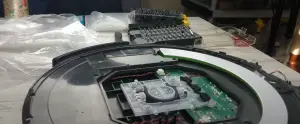
What Happens if My Roomba Gets Wet?
If your Roomba gets wet, it is important to remove the battery and let the robot dry completely before using it again. Liquid can damage the electronic components inside the robot, so it is important to take care when cleaning up spills.
Can You Fix a Roomba That Got Wet?
Some people might try to dry out the Roomba by using a hairdryer or some other means, while others might simply take it to a repair shop. Ultimately, it depends on how wet the Roomba got and what kind of damage may have been done.
How Much Does Roomba Water Damage Cost?
The cost of repairing or replacing a Roomba that has been damaged by water can be expensive. Depending on the extent of the damage, repairs can range from a few hundred dollars to more than one thousand dollars. If the device needs to be replaced, the cost may be even higher.
Can I Wash My iRobot Filter?
The Roomba’s filter cannot be washed. The filter is designed to trap dirt and debris, and if it is washed, the filter will not be effective. The filter should be replaced every 3 months for optimal performance.
Can I Clean My Roomba With Water?
The Roomba is a vacuum cleaner that can be cleaned with water. However, the manufacturer recommends not using water to clean the robot, as it may damage the device. Instead, the robot can be cleaned with a damp cloth.
Final Thoughts
Roomba water damage, though an avoidable issue, can happen. That’s why we hope you now know how to react if you notice your Roomba ran over water. If it’s only a tiny puddle of water, its damage won’t be extensive.
You can use the tips we have listed to diagnose the issue and seek appropriate help whenever your Roomba runs over water.
Relevant Resources:
